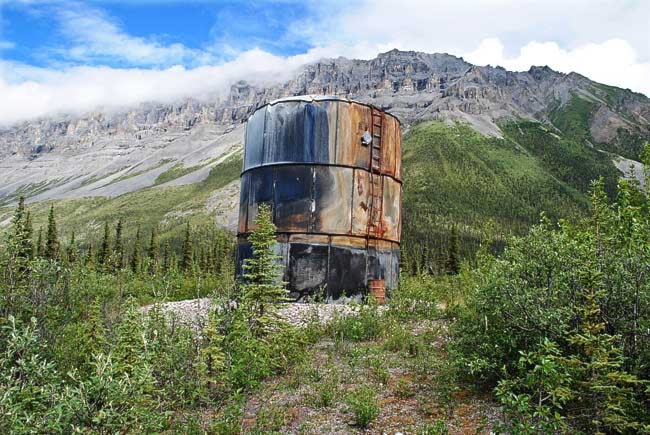SNAKE RIVER
Warped by time and discoloured by fire, a monster fuel storage tank sits exactly where its steel plates were welded into place nearly 50 years ago.
It should be removed and the site cleaned up. But, despite assurances from government and industry officials, there are still questions about whether this will happen. And when.
Erected by the Standard Oil Company of California - now known as Chevron - following its 1961 discovery of iron ore near the Snake River, the tank is but one remnant of that long-ago mineral play along the Yukon and Northwest Territories border.
The tank is empty now, but at the height of the company’s exploration activity in 1963-64, it stored as much as 285,000 litres of diesel and aviation fuel that was used to power bulldozers, drill rigs, helicopters and airplanes.
The once-glimmering tank, built along with a 1.3-kilometre gravel airstrip, also served as a beacon to pilots ferrying workers and supplies from Whitehorse. The strip was linked to the 45-person base camp by a 14-kilometre road up what was unofficially known as Iron Creek.
On this muggy July day, the massive industrial monument looks sorely out of place.
Surrounded by boreal greenery that carpets the landscape beneath the rugged peaks of Mount Corp, its most recent pilgrims appear to have been of the four-legged, furry variety.
Beside the tank, bears have carved a wallowing hole in the dark soil, drenched with fuel that’s leaked from a ground-level valve. Thin strands of grizzly hair cling tenuously to a row of nuts and bolts holding the side panels together.
Dozens of old, rusty 45-gallon fuel drums - some full, some empty, some a little of both - lie scattered in nearby piles, also dotted with bear diggings.
Across a murky pond, littered with miscellaneous garbage, the airstrip that once proudly received DC3s is mostly overgrown with trees and almost unrecognizable.
The old radio shack and tower have since been pressed into service by the local hunting company.
Formally designated as a “contaminated site” in the early 1990s, apart from two federally funded remediation studies, no actual cleanup work has ever been carried out.
The airstrip site doesn’t sit on Chevron’s current block of iron leases - it begins a few kilometres to the east and covers hundreds of acres of land on both sides of the border.
And therein lies the ambiguity about the proposed remediation work.
The company and the territorial government have told local media Chevron will clean up its mess, but there has been some confusion about just which mess they are referring to.
In addition to the airstrip site, a recent Yukon government inspection has turned up five other small sites on Chevron’s existing leases. Old fuel containers, camp material, like lumber, and drilling mud are among the other castoffs.
Chevron applied to renew its 525 Yukon leases last September, even though they don’t expire until 2013-14.
Now it’s up to the Yukon government to decide whether to grant the renewal, or wait until the company has cleaned up the area before signing the ground away for another 21 years.
The iron leases are located in an area slated for the highest level of wilderness protection under the proposed Peel Watershed land-use plan.
Chevron, one of the largest oil companies in North America, also holds oil/gas interests in the western part of the watershed, near the Dempster Highway.
Mary Walden is a Yukon writer and journalist. Her partner Blaine runs Walden’s Guiding and Outfitting in the Peel Wateshed. You’ll find more photos and stories of the Peel on her blog at http://peelwatershed.blogspot.com.
